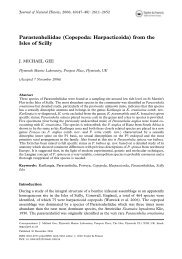An Updated Classification of the Recent Crustacea
An Updated Classification of the Recent Crustacea
An Updated Classification of the Recent Crustacea
Create successful ePaper yourself
Turn your PDF publications into a flip-book with our unique Google optimized e-Paper software.
knowledge on <strong>the</strong> phylogeny and <strong>the</strong> classification<br />
<strong>of</strong> <strong>Crustacea</strong>, and obviously new, and perhaps<br />
strong, changes will come in <strong>the</strong> near future. However,<br />
we need to put in order our present knowledge<br />
<strong>of</strong> <strong>the</strong> group.<br />
Submitted by Enrique Macpherson,<br />
Centre D’Estudios Avancats de Blanes, Spain<br />
DECAPODA: ANOMURA<br />
I can only address your classification <strong>of</strong> <strong>the</strong> <strong>An</strong>omura.<br />
Forest (1987a, b), while concurring with<br />
McLaughlin’s (1983) argument that <strong>the</strong> Paguridea<br />
represented a monophyletic taxon, did not agree<br />
with her elimination <strong>of</strong> <strong>the</strong> Coenobitoidea as a superfamily.<br />
Consequently he elevated <strong>the</strong> Paguridea<br />
to rank <strong>of</strong> Section and reinstated <strong>the</strong> superfamily<br />
Coenobitoidea to include <strong>the</strong> families Pylochelidae,<br />
Diogenidae and Coenobitidae. He did concur with<br />
McLaughlin’s removal <strong>of</strong> <strong>the</strong> Lomidae and its elevation<br />
to superfamily. He did not address <strong>the</strong> hierarchical<br />
ranking <strong>of</strong> <strong>the</strong> o<strong>the</strong>r <strong>An</strong>omuran superfamilies.<br />
McLaughlin and Lemaitre (1997) acknowledged<br />
Forest’s sectional ranking for <strong>the</strong> Paguridea,<br />
but continued to refer to all <strong>of</strong> <strong>the</strong><br />
anomuran major taxa as superfamilies. However,<br />
Forest et al. (2000), Forest and McLaughlin (2000),<br />
and de Saint Laurent and McLaughlin (2000) all<br />
refer to <strong>the</strong> superfamilies Coenobitoidea and Paguroidea,<br />
under <strong>the</strong> Section Paguridea.<br />
I personally still believe that <strong>the</strong> Paguridea represent<br />
a monophyletic taxon; however, I also believe<br />
that Forest’s argument for reinstatement <strong>of</strong> <strong>the</strong><br />
Coenobitoidea is valid. For hierarchical balance<br />
within <strong>the</strong> <strong>An</strong>omura, perhaps <strong>the</strong> o<strong>the</strong>r superfamilies<br />
should similarly be elevated to Section rank in<br />
your classification.<br />
Additional References<br />
Forest, J. 1987a. Les Pylochelidae ou ‘‘Pagures symetriques’’<br />
(<strong>Crustacea</strong> Coeno-bitoidea). In Résultats des<br />
campagnes MUSORSTOM. Mémoires du Muséum<br />
National d’Histoire Naturelle, série A, Zoologie, vol.<br />
137, 1–254, figs. 1–82, plates 1–9.<br />
. 1987b. Ethology and distribution <strong>of</strong> Pylochelidae<br />
(<strong>Crustacea</strong> Decapoda Coenobitoidea). Bulletin <strong>of</strong><br />
Marine Science 41(2):309–321.<br />
Forest, J., M. de Saint Laurent, P. A. McLaughlin, and R.<br />
Lemaitre. 2000. The marine fauna <strong>of</strong> New Zealand:<br />
Paguridea (Decapoda: <strong>An</strong>omura) exclusive <strong>of</strong> <strong>the</strong><br />
Lithodidae. NIWA Biodiversity Memoir 114 (in<br />
press).<br />
Forest, J., and P. A. McLaughlin, 2000. Superfamily Coenobitoidea.<br />
In The marine fauna <strong>of</strong> New Zealand:<br />
Paguridea (Decapoda: <strong>An</strong>omura) exclusive <strong>of</strong> <strong>the</strong><br />
Lithodidae, eds. J. Forest, M. de Saint Laurent, P. A.<br />
McLaughlin, and R. Lemaitre. NIWA Biodiversity<br />
Memoir 114.<br />
McLaughlin, P. A. and R. Lemaitre. 1997. Carcinization<br />
in <strong>the</strong> <strong>An</strong>omura—fact or fiction? I. Evidence from<br />
adult morphology. Contributions to Zoology, Amsterdam<br />
67(2):79–123, figs. 1–13.<br />
Saint Laurent, M. de, and P. A. McLaughlin, 2000. Superfamily<br />
Paguroidea, Family Paguridae. In The marine<br />
fauna <strong>of</strong> New Zealand: Paguridea (Decapoda:<br />
<strong>An</strong>omura) exclusive <strong>of</strong> <strong>the</strong> Lithodidae, eds. J. Forest,<br />
M. de Saint Laurent, P. A. McLaughlin, and R. Lemaitre.<br />
NIWA Biodiversity Memoir 114.<br />
Submitted by Patsy McLaughlin,<br />
Shannon Point Marine Center,<br />
<strong>An</strong>acortes, Washington<br />
DECAPODA: BRACHYURA<br />
As before, I think that <strong>the</strong> Oregoninae <strong>of</strong> Garth<br />
should be elevated to a family. I contacted Michel<br />
Hendrickx about <strong>the</strong> classification. He in turn<br />
quoted a paper that provided larval evidence for<br />
<strong>the</strong> distinction <strong>of</strong> <strong>the</strong> group as a family, and said<br />
that he will treat <strong>the</strong> group as such in his forthcoming<br />
work on crabs. Please contact Michel for fur<strong>the</strong>r<br />
information. If you cannot contact him, let me<br />
know and I’ll find that larval paper for you. My<br />
own suspicion is that <strong>the</strong> oregoniids are not covered<br />
in most monographs because <strong>the</strong>y are a cirumArctic<br />
and boreal nor<strong>the</strong>rn hemisphere group that does<br />
not range at all into tropical waters, where most<br />
researchers work!<br />
Submitted by Mary K. Wicksten,<br />
Texas A&M University<br />
DECAPODA: BRACHYURA<br />
I strongly believe that <strong>the</strong> Pinno<strong>the</strong>ridae are not<br />
monophyletic. So if I argued that this family<br />
‘‘should remain in <strong>the</strong> Thoracotremata based on evidence<br />
from DNA sequencing’’ [as cited in your<br />
classification], I should add that this might only be<br />
true for some <strong>of</strong> its constituent subfamilies or genera.<br />
My statement was made based on <strong>the</strong> phylogenetic<br />
position <strong>of</strong> Pinnixa in molecular analyses<br />
that showed a strikingly close relationship to <strong>the</strong><br />
Ocypodinae (Schubart et al., 2000a).<br />
I also think that <strong>the</strong> Ocypodidae in <strong>the</strong> traditional<br />
sense as well as <strong>the</strong> Ocypodoidea as defined in<br />
<strong>the</strong> latest draft <strong>of</strong> your classification might not be<br />
monophyletic. Molecular as well as larval morphological<br />
data suggest a close relationship between <strong>the</strong><br />
Varunidae (Grapsoidea) and <strong>the</strong> Macropthalminae<br />
(Schubart et al., 2000a; Schubart and Cuesta, unpublished).<br />
I think that this possible phylogenetic<br />
link would be ano<strong>the</strong>r reason to elevate ocypodid<br />
subfamilies to family level as already considered in<br />
your draft and suggested for <strong>the</strong> Grapsidae (Schubart<br />
et al., 2000b). This would certainly make justice<br />
to ocypodoid morphological diversity and allow<br />
a more objective comparison with o<strong>the</strong>r thoracotremes<br />
in <strong>the</strong> future.<br />
I disagree on <strong>the</strong> use <strong>of</strong> <strong>the</strong> superfamily name<br />
‘‘Grapsidoidea.’’ Since <strong>the</strong> stem <strong>of</strong> <strong>the</strong> name is<br />
Graps- (based on Cancer grapsus Linnaeus, see also<br />
family name Grapsidae) and <strong>the</strong> ending for superfamilies<br />
is -oidea, <strong>the</strong> superfamily should be called<br />
Grapsoidea (and not Grapsidoidea). The fact that<br />
<strong>the</strong> term Grapsoidea has been used in <strong>the</strong> past for<br />
a much wider systematic grouping <strong>of</strong> eubrachyuran<br />
Contributions in Science, Number 39 Appendix I: Comments and Opinions 111











